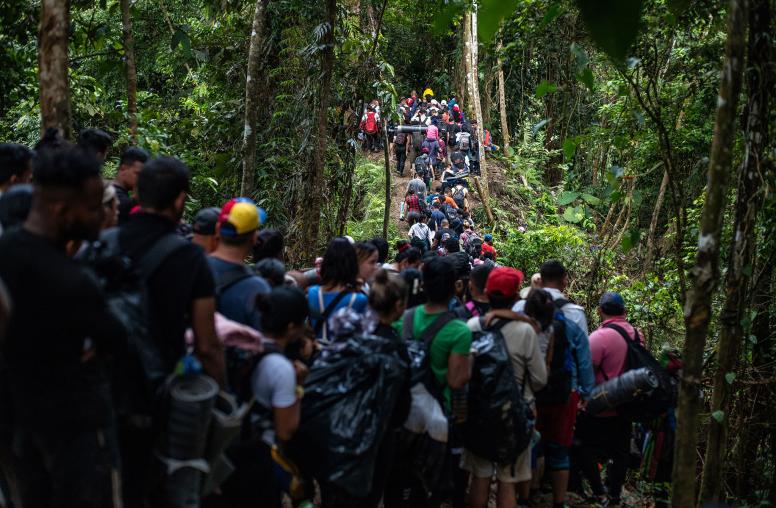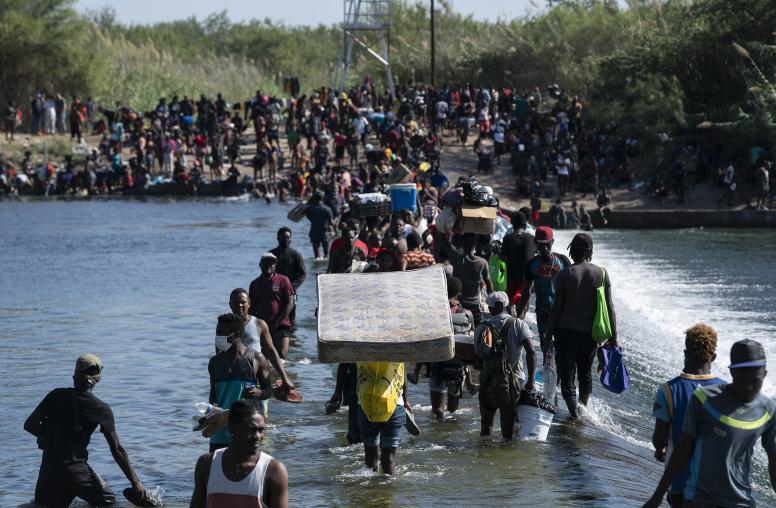Nancy Lindborg on a New Prevention Paradigm
Following the release of the Task Force on Extremism in Fragile States’ final report, Nancy Lindborg explains why a new prevention paradigm is needed to address the root causes of extremism in fragile states. “We are in a moment of convergence and shared desire to figure out how to do these tough tasks differently,” says Lindborg.
On Peace is a weekly podcast sponsored by USIP and Sirius XM POTUS Ch. 124. Each week, USIP experts tackle the latest foreign policy issues from around the world.
Transcript
Tim Farley: We've been updating you on the progress and yesterday an event noting the release of the report from the joint Task Force on Extremism in Fragile States launching a new approach. This was an event that took place yesterday and we want to get the update on this. Nancy Lindborg, president of the United States Institute of Peace, joins us here on POTUS. She is tweeting @nancylindborg. Nancy, welcome back, thanks for being here.
Nancy Lindborg: Great to be with you this morning, Tim.
Tim Farley: You've done this before, but maybe just set the backdrop for this. I know that this is bipartisan, Senator Lindsey Graham, Senator Chris Coons among those who were there yesterday. Tell us a little bit more about the backdrop of what this report was about.
Nancy Lindborg: Sure. USIP was chartered by Congress to develop 'a comprehensive plan for understanding the conditions for violent extremism in the Horn of Africa, the Sahel, in Africa and the Middle East.' And so we put together a bipartisan task force chaired by Governor Tom Kean and Congressman Lee Hamilton, who you may recall were the co-chairs of the 9/11 Commission. And the backdrop is we were asked to do this report because since 9/11, the U.S. has spent about 5.9 trillion dollars combating extremism and terrorism, and have been very successful in keeping the homeland safe.
Nancy Lindborg: There has been some success in defeating terrorists as they try to hold territory, but the real victory is not going to be through military. And what Governor Kean and Congressman Hamilton have said is that the unmet recommendation from the 9/11 Commission was to adopt a preventive strategy to address violent extremism overseas. So that's the fundamental goal of the report that was released yesterday, is to articulate a preventive strategy for the United States to do with partners.
Tim Farley: Does that preventive strategy include some tactics? How specific does it get? Nancy Lindborg: Well, it really outlines three major recommendations. And the first is ... it sounds really simple, but it's deeply important and hasn't been done yet, and that is there is a high level political commitment in our government around a unity of effort to align all of our U.S. policy and assistance instruments around a shared understanding of what are the conditions in fragile states that give rise to violent extremism.
Nancy Lindborg: And then the second two are how to put that into action. The first is looking at a range of policies and processes that get through the bureaucratic impediments from accomplishing that, and the third is a shared global fund for enabling us to burden share with our partner/donor nations and to do so in a compact model. For those who know the Millennium Challenge Corporation, doing it in agreement, a shared agreement with specific benchmarks with the fragile countries and the affected populations themselves. So it's really a different way of doing things.
Tim Farley: I wonder ... again we're speaking with Nancy Lindborg, President of the United States Institute of Peace. This is the final report from the Task Force on Violent Extremism in Fragile States we're discussing ... to whom does it fall to execute this strategy? In other words, is this congressional? Is this executive branch? Is this in tandem? How does this happen?
Nancy Lindborg: It really requires both, and what I'm very encouraged by is that it was launched, as you noted, Tim, it was launched on the Hill yesterday with support from bipartisan support, Senator Graham, Senator Coon, as well as Congressmen Engel and Congressman McCaul from the House side. And there is legislation coming soon, this week maybe, from both the House and the Senate that very much align with the findings and recommendations of the report. And of course there was recently the Build Act was passed, which is new legislation that enables support for private sector investment in fragile states. That was deeply supported by the Administration.
Nancy Lindborg: So we are in a moment of, I think, convergence of shared desire to figure out how to do these tough tasks differently. There's a shared awareness that we really haven't had the success that we need in combating extremism around the world. As I said, it's been 5.9 trillion dollars and we've seen, in fact, a rise in extremism, particularly in the Horn and the Sahel of Africa and the Middle East. So this is laying out a very practical roadmap that looks at a prevention strategy. It's pretty common sense, but it will take some very different ways of doing business around our government, and take both congressional and administrative support.
Tim Farley: Okay, a quick logistical question. This global fund you referred to, who would administer that? Is that from the State Department?
Nancy Lindborg: The Partnership Development Fund would be led by the State Department and U.S. Agency for International Development. It would definitely require international buy in. We want both burden sharing, but also as a way to get coordination among that wider group of actors, so that there's this shared understanding of what are we trying to accomplish both across the U.S. Government and with our partners. And there's some great models out there if you look at how we were able to collectively tackle HIV/AIDs with a similar kind of approach.
Tim Farley: And the last question, this has to do with the sense of how much the United States should be involved in intervening in some of these countries. But we're talking fragile states, we're not talking about necessarily nation states who might push back on these things. I guess, I mean I could be wrong. Explain that.
Nancy Lindborg: What we're seeing is that fragile states, which are those states where you've got a broken social compact between a government and its people. And we're seeing that the states that are the most fragile are really the common denominator for violent extremism, for poverty, for sources of migrations and refugees. We will not always find willing partners among those states and their affected populations. But key will be those who are willing to engage in partnership with the Partnership Fund, that it will be a jointly agreed upon program.
Nancy Lindborg: One of the things that we've learned is that change really has to happen led by the people who are affected. We have not had success when we go in and say, 'Here's how to do it.' So it's got to be support that is both long term and able to be more flexible in how it's used on the ground, with shared agreement and benchmarks and accountability, but not designed by us.
Tim Farley: I do appreciate you joining us, Nancy. Thanks so much for being on the show today.
Nancy Lindborg: Thank you, Tim, and stay tuned. We look forward to continuing to move forward with the new legislation.
Tim Farley: Yeah, the final report is not the final action, right?
Nancy Lindborg: Right, but we're looking forward to turning report into action.
Tim Farley: All right, Nancy Lindborg, president of the United States Institute of Peace joining us here. The final report being delivered on the Task Force on Violent Extremism in Fragile States. You can read more on the website if you want to go to USIP.org. That's where you will find this. You can actually look at this final report Preventing Extremism in Fragile States: A New Approach. The Task Force offers three recommendations as she just noted, and you can read on at the website.
Tim: You can also see the Twitter handle @nancylindborg, L-I-N-D-B-O-R-G.


